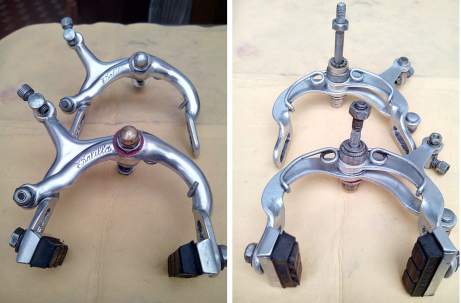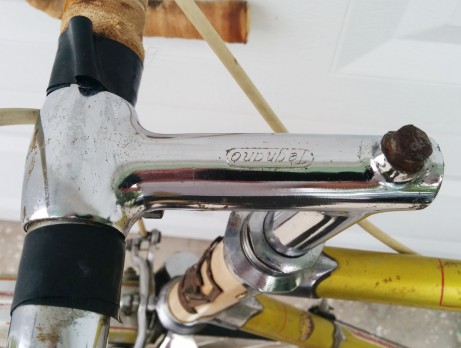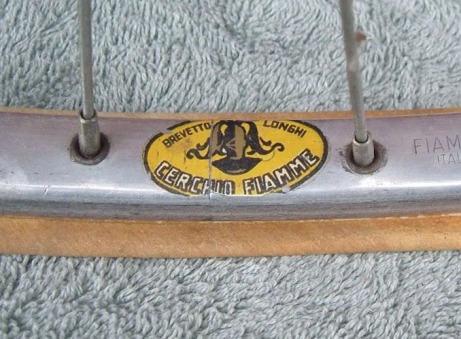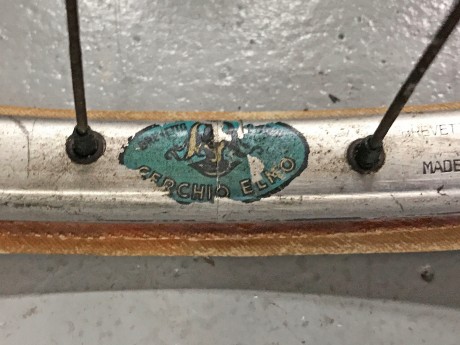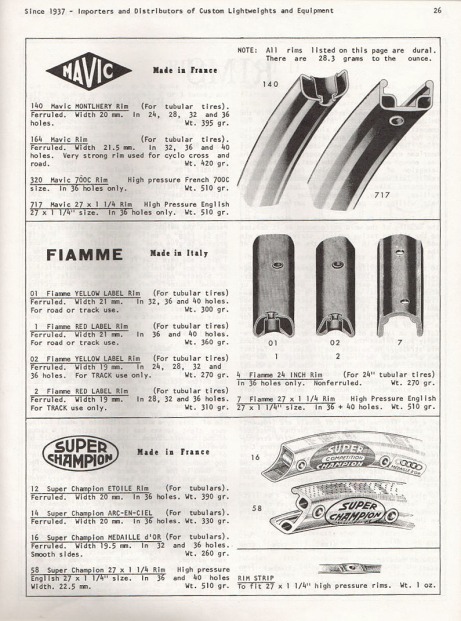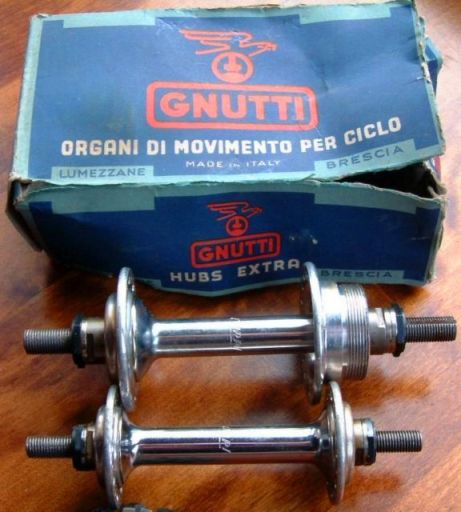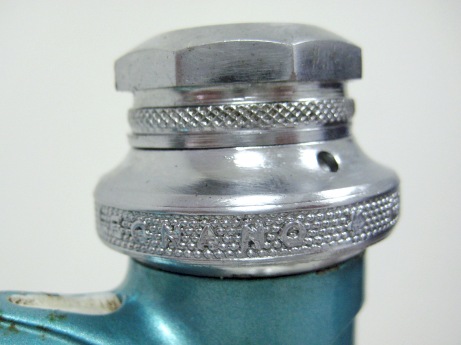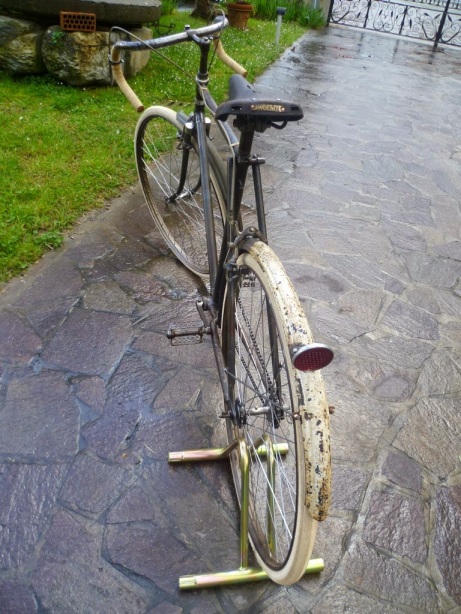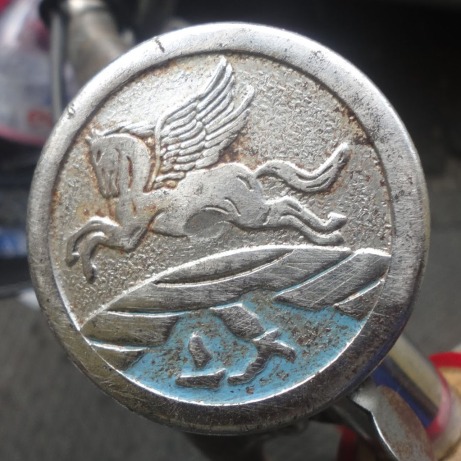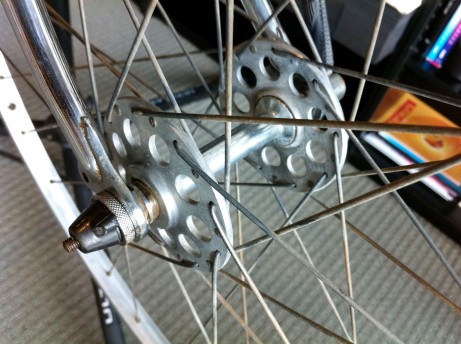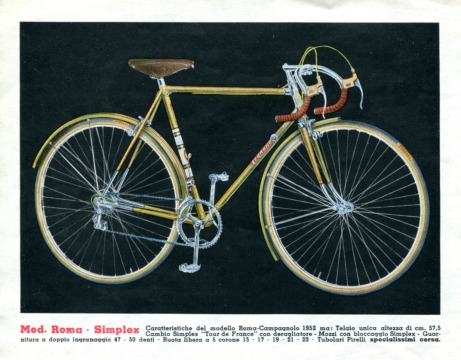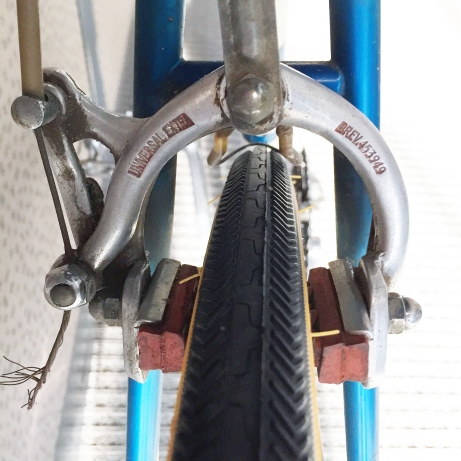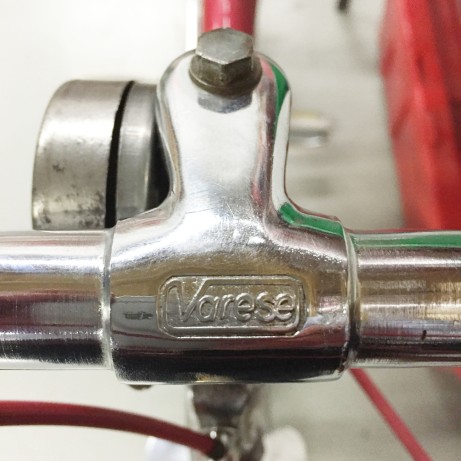Updated January 14, 2022.
Introduction
Emilio Bozzi S.p.A. not only produced the Legnano, Frejus, Woolsit and Perla bicycles but the company was also a major distributor of bicycle parts to other builders, brands and shops throughout Italy as well as their resellers around the world. The 335 page catalog in the image above was published by Bozzi in 1950 and it reflects the magnitude of the bicycle components they distributed from all of the major Italian producers. As an aside, the thousands of detailed illustrations in this catalog are spectacular and a work of art in their own right. With some time I plan to scan this enormous volume and make it available on the site as a PDF document for readers to enjoy.
Although Legnano began in 1902 or 1908, depending on how you count it, I have chosen to begin this component review in 1920 as it aligns with the beginnings of Ambrosio, Way-Assauto and Universal, three of the primary components on Legnano bicycles for decades. At first I was going to end it with the late 60’s which many enthusiasts see as the end of Legnano’s golden era, however I have extended the end of the review to 1974. Also by 1974 many of the long-standing Italian component manufacturers were either gone or near gone as the Japanese invasion went into overdrive.
It is important to keep in mind how little bicycle components changed through many of these decades compared to modern times. One of the most significant innovations during this period was the introduction of aluminium to replace steel in the manufacture of rims, hubs, handlebars, stems, seat posts and pedals. Other key innovations were the invention of the quick release lever and parallelogram derailleur by Tulio Campagnolo, both of which are still with us today. So lets take a look at who was producing what in Italy during the ‘golden years’ of Legnano.
Ambrosio and T.T.T. — Handlebars, Stems and Rims
Founded in 1923 by Giovanni and Guiseppe Ambrosio, this component manufacturer was considered one of the Italian pioneers in the use of aluminium for bicycle parts and produced a range of high-quality handlebars, stems and rims. Acquired by the Marzorati family in 1961, the Ambrosio brand lived on with a greater emphasis on rim production in the late 60’s and 70’s.
This is where the history of Ambrosio and T.T.T take different paths according to this report on Velobase.com.
“In 1961 (when Marzorati shows up?), long term employee, Mario Dedioniggi leaves Ambrosio and founds ‘Turin Tube Technology’, which is soon to become ‘Tecnologia del Tubo Torino’. He also starts with steel bars and stems. He soon converts to aluminum with Ergal coming in 1975 for the Superleggero bar. In 1985, Dedioniggi leaves and sells the brand to Antonio Colombo et al. Colombo founds a new company, so as not to compete directly with Cinelli with the plans to call it ‘3TTT S.p.A.” but the clerk forgets the other two ‘T’s’ and it becomes ‘3T’ …So, they appear to be parallel companies of the same parent in the 1960’s-70’s with ties, but not the same company and to this day, have different addresses.”
There would seem to be some substance in this account but a few unanswered questions. The Ambrosio brand of handlebars and stems can be found in production through to the early 1990’s and Ambrosio rims continue on to this day. The current Ambrosia website describes their history as going back to 1932 and the Ambrosio Champion handlebar. However is this the same Ambrosio acquired by the Marzorati family, has production passed on to another owner at some point in time or is it simply the brand name that was purchased and lives on today?
Returning to the early days, almost all Legnano road bikes including the Gran Premio, Roma, Competizione and Specialissima models were fitted with Ambrosio handlebars and stems, or T.T.T. bars and stems after 1961 and through into the 1970’s.
Ambrosio was also a quality producer of aluminium rims for both tubular and clincher tires. The photo below is a clincher style rim that Legnano used on the 1971 Mod.50 Sportivo ‘Condorino’ that is featured on this site. Note the ‘High Pressure’ designation on the rim decal is a relative term in the context of today’s high-pressure clincher tires. Thus far I have not come across a Legnano road bike that was factory fitted with Ambrosio tubular rims.
Atom – Hubs, Pedals and Freewheels
Atom was a French company that began after 1945 producing hubs and freewheels in 3,4 and 5-speed configurations. The component you come across most often is a low flange, one-piece aluminium hub with QR that was very popular. In a letter by Steve Griffith to Lightweight News 42 (Nov/Dec 2012) he comments that the LF Atom hubs were quite serviceable, very popular and one of the cheapest branded hubs you could buy during the 60’s and 70’s. During the 1960’s, Atom and another well-know French hub and freewheel manufacturer were taken over by Maillard.
Here is a photo of an Atom, or more correctly MM Atom (Monsieur Maillard), large flange hub branded for Legnano fitted to the 1971 Mod.50 Sportivo that is featured on this site. Looking at the hub body you can see the similarity to Normandy hubs (acquired by Maillard) and of the same mid-range quality. The photo that follows is an early Atom 3-speed freewheel. The last photo is a pair of Atom quill pedals with a good bit of corrosion on the cages. From my findings and ramblings, I have no reference for the Atom pedals being used by Legnano.
Balilla – Brake callipers and levers, Toe Clips
Balilla was not a large manufacturer of bicycle parts by all accounts and many of their products were of average quality. The image below is a mid-quality centerpull brake branded for Legnano. The second photo below shows a sidepull brake calliper that dates to the 50’s and is not unlike the Universal brake calliper of that same time and without a QR mechanism. The early Balilla quality also seems to be much higher than what followed.
To date I have no reference to indicate whether Balilla sidepull brakes were fitted to a Legnano model however I have seen them branded for Frejus (the other Bozzi SpA brand acquired in 1946-47). The last photo is a pair of Balilla toe clips however there is some suggestions that these were only branded for Balilla and made by another manufacturer.
Brooks — Saddles
Brooks saddles may seem an unlikely candidate on an Italian bike, particularly in the pre-EU era when important tariffs were intentionally high in all European countries as a way of protecting and fostering national production and consumption. In fact, so high were the import tariffs that Simplex produced some of their components in Italy and similarly Campagnolo and F.B. had a small production facility in France.
However despite the premium, the Brooks B17 saddle was a superior product and an internationally recognized brand, so it was fitted to most Roma and some Gran Premio models. So popular was the Brooks B17 saddle that the Italian saddle maker Italia (Sella Italia) produced and promoted a model called the B17. That bit of creative license would have surely hit the courts if it had happened today.
Special mention should be made of the Brooks B17 Campagnolo Model that was produced for only a short time between 1958 and 1963 (by most accounts) and exclusively for Campagnolo. The Campagnolo Model had narrower rails that provided substantially greater fore and aft adjustment than the conventional Brooks B17 saddle. To facilitate the narrower rails, Campagnolo produced a special narrow rail seat post during these same years to bring it all together.
The top of the B17 was embossed with an oval mark with the words Campagnolo Model as can be seen in the photo below. This saddle and post combination was used on some but not all Roma Olimpiade models. Production of the B17 Campagnolo Model was discontinued on or about 1963, in part perhaps because the the narrow rails often resulted in stress fractures and/or failure where the rod frame joins the cantle. Something to look out for if you are purchasing or fitting one of these saddles.


Campagnolo
There is absolutely nothing to be taken away from Tulio Campagnolo and his enormous contribution to advancing the technology of the bicycle, and particularly competitive cycling, that continues to this day. However time does have a way of loosing some of the fine print, particularly in the face of personalities and empires that become larger than life.
On that note, it has been said that Campagnolo purchased the patent for the parallelogram design that launched the Gran Sport rear derailleur in 1950 and that it was not of his own invention. And while Campagnolo did invent and patent the QR mechanism, the three-piece Gran Sport hubs were the work of Fratelli Brivio who held the patent (1931) and ran the initial production for Campagnolo and other Italian brands (ie. Bianchi, Umberto Dei, Atala, etc.) and of course under the F.B. as well.
Having said that, most of the leading Italian brands, including the top-of-the-line Legnano Roma models were using Campagnolo components from Tulio’s first days, beginning with the Gran Sport hubs and the early Cambio Corsa and Paris Roubaix shifting mechanisms that took Bartali and Coppi to victory in the 1940’s.
With the mass availability of the Campagnolo Gran Sport and Sport series derailleur systems in the early 50’s, almost all Legnano road bikes and the top city bikes were fitted with Campagnolo drivetrains well into the 70s. With Campagnolo’s introduction of the iconic Record aluminium crankset in 1958, the Roma Olimpiade shipped with a complete Campy group in that same year (minus the brake set that was still a decade away) and sported a Campagnolo ‘Record Gruppo’ decal on the down tube.
To the best of my knowledge, the only component that Campagnolo manufactured themselves and ‘cross-branded’ were their all aluminium hubs that were released in 1958. Campagnolo offered this service to all the prominent Italian marques including Atala, Bianchi, Frejus, Maino, Umberto Dei and of course Legnano. However, this practice seems to have disappeared by the late 60’s as Campagnolo began to realize the commercial importance of promoting their own brand exclusively.
Cinelli — Handlebars and Stems
Founded in Florence by Giotto Cinelli and his brother Arrigo in 1940 as Cicli Giotti Cinelli S.r.l. producing steel bars and stems. In 1947, Cicli Giotti Cinelli S.r.l. is transferred to Cino’s enterprise Cinelli & C. S.r.l., located at Viale onza 10 in Milano. Cinelli is a company of the finest quality that continues on to this day producing bicycles and components. A Cinelli timeline compiled by Chuck Schmidt can be found on Velo Retro.
It is not commonly known that during the early years, Cinelli produced steel handlebars and stems for high-end city bikes as well as road bikes. A pair of Cinelli bars are fitted to the 1950 Frejus Superleggera city bike on this site, exhibiting all of the detail and refinement you would expect from Cinelli. Below is a Cinelli road stem and bars in steel, engraved for Legnano on a 1954 Roma Olimpiade.
In 1963 Cinelli transitioned their steel handlebar and stem production to aluminium and the classic 1A stem was born. However to the best of my knowledge, Legnano did not fit Cinelli allow stems and bars to their premier road bikes, however I am sure there were many retrofits given the enormous popularity of the 1A stem among enthusiasts.
S.A. Fiamme — Rims, Handlebars and Stems
I have yet to find a reference that dates the founding of S.A. Fiamme of Milano, a component maker that is best known for the production of aluminium rims but also produced high-quality stems and handlebars. What is published of Fiamme’s history takes shape in the early 1930’s when Mario Longhi patented the double eyelet, hollow aluminium rim on January 5th, 1934 just two hours prior to a similar patent being filed by Mavic of France (source: Hilary Stone; Mavic). Longhi licensed the patent to Fiamme until its expiration and also to Mavic until 1947 according to the Mavic website.
Below is a drawing of the original aluminium Fiamme sprint rim incorporating the Longhi patented construction as illustrated in their 1935 catalog (source: Hilary Stone) and following that an advertisement for the Fiamme sprint rims in the March 2, 1934 issue of Cycling magazine (source: Classic Lightweights UK).
The first image below is from the extensive 1952 Emilio Bozzi SpA parts catalog, offering the Fiamme tubular rim with and without eyelets. Note the Fiamme logo incorporates an image of Pegasus, the mythological winged horse as opposed to the illustration of a helmet that we are most familiar with. Also the label is in the shape of a ‘marquis’ rather than an oval. I have yet to come across a tubular type rim with the Pegasus illustration on the label.
The second image below is the Fiamme rim with eyelets on the 1946 Legnano Tipo Roma in my collection. The ‘Brevetto Longhi’ license stamped above the ‘S.A. Fiamme’ branding can also be found in the identical format on my original 1958 Roma and my 1963 Roma. However, the Fiamme rims (with eyelets) on my original 1966 Roma are simply stamped ‘S.A. Fiamme’ with ‘Made in Italy’ below, suggesting that the Longhi patent had expired by that time. Today a utility patent in Italy has a life span of 20 years however it may have had a longer life in the past. I should also mention that the valve hole on all of the above rims has a reinforcing eyelet.
The third image below is courtesy of a post on Bike Forums by ‘iab’ who references it to a 1948-1949 Viscontea Pista. What is notable is this early Fiamme red label rim is without the reinforcing spoke eyelets and is simply engraved ‘Fiamme Milano’, and without the words ‘Brevetto Longhi’ as the rim does not make use of the Longhi patent.
I am limiting this review to pre-1970 production however Fiamme went on to produce rims well into the 1980’s by all accounts. Unfortunately like so many dominant Italian component manufacturers that got their start in the 1920s and 1930s, changing European trade laws along with the Japanese invasion of lucrative foreign markets may have proved too much for Fiamme and they went out of business. It is reported that Fiamme’s assets were purchased by FIR of Italy (Fabbrica Italiana Ruote).
Prior to 1970 I have come across Fiamme tubular rims with four different label types in three colours. The first image below is the red label Fiamme pista rims fitted to a 1952 Fiorelli track bike that is featured on on the Classic Cycle website. The red label rims were also produced in a road profile, widely used and highly rated from all accounts I have come across. The yellow label rims (oval shape label) were of a lighter weight (approx. 50-60g) and were also available in both road (second image below) and pista profiles for special events, time trials and/or lighter riders.
Although I have yet to verify this statement, online comments would suggest that the green label rim marked ‘Cerchio Elmo’ rather than ‘Cerchio Fiamme’ was a heavier or more robust rim than the red label rim. The green label rims are factory spec on many of the Legnano Roma and Gran Premio models in my collection dating back to 1958. As most of these same bikes in my collection are imports to North America, the more robust green label Fiamme rim may have been in response to the mixed road conditions in NA at that time. It is interesting that the word ‘elmo’ in Italian translates to ‘helmet’ in English, derived perhaps from the illustration of a helmet in the Fiamme logo.
Not to be missed, Fiamme also produced aluminium clincher rims that were designated with a yellow marquise-shaped label with the resurrected Pegasus logo as discussed earlier. The image below is of a 27 inch clincher rim (with Schrader valve holes) original to the 1961 Gran Premio on this site, a Legnano import to the United States with clincher tires and Schrader valves that could be ‘pumped up’ at any local gas station. Online reports suggest these Fiamme clincher rims were in production until approx. 1975.
The third image below is from the 11th Edition in 1974 of Gene Portuesi’s ‘Cyclopedia’ catalog (source). Given print production practices at the time, I suspect the Fiamme illustrations were produced much earlier than 1974 and carried over from one catalog to the next as bicycle components did not change up on a yearly basis as they do today.
Updated January 14, 2022
Wim Hermans of the Netherlands is a vintage bike enthusiast and he was kind enough to pass along a photo of a very early Fiamme rim (photo below) with a rarely seen rim decal and a production year that we estimate to be sometime between 1934 (when Longhi registered the patent) and 1940.

The engraving to the right of the rim decal is common to later Fiamme rims through to the early 1960s when the Longhi patent expired. However the engraving to the left of the decal is not. Breveté SGDG was a a form of French patent that ceased to exist in 1968. The name was a common abbreviation for “Breveté Sans Garantie Du Gouvernement“. (Wikipedia).
Coincidentally, Wim Hermans is a patent professional and he wrote of SGDG, “It seems it was some kind of untested patent. Quick and dirty or just a way of registration. The validation then had to be tested in a possible later dispute. We have the same system still here in the Netherlands.”
As mentioned earlier, Longhi only eclipsed Mavic by two hours in registering the patent for the double-eyelet, hollow cross-section design of his rim, so the SGDG engraving may have been a bit of a warning to the French cycling manufacturers that the design was also protected in France or in other words “hands off”. If a reader has any additional information or samples of this early Fiamme rim I would enjoy hearing from them.
And to conclude this post and as initially mentioned, Fiamme also produced a fine line of aluminium handlebars and stems. I am estimating the stem in the image below (courtesy of Speedplay) was produced in the late 50’s to early 60’s based on the exposed detailing of the binder bolt and overall design which is very similar to the stems from Ambrosio during those same years. I do not believe that Fiamme stems and bars were ever used by Bozzi Spa on Legnano or Frejus production.
Fratelli Brivio — Hubs, Cranksets and Bottom Brackets
Camillo Brivio (Fratelli Brivio S.A. of Brescia, IT) patented the 3-piece hub design in 1931, a couple of years before Tulio Campagnolo filed his patent for the quick release mechanism in 1933. As makers, F.B. collaborated with Tulio Campagnolo to produce the hollow axles that could be used with his new QR mechanism in lieu of a solid axle and wing nuts. It is worth noting that Campagnolo was first registered as an inventor, not as a manufacturer, and it is believed that F.B. prototyped Tulio’s QR design and in the process made meaningful contributions to the first production units as most makers do.
F.B. also produced steel cranksets and bottom brackets of a high quality that were pretty much identical in design to Magistroni and Way Assauto. However to the best of my knowledge F.B. cranks were not factory fittings on Legnano or Frejus road bikes.
As with so many of the Italian component makers that began in the 1920’s and 1930’s, Fratelli Brivio appears to have ceased production in the late 1960s. There is some commentary that Campagnolo purchased F.B., however there is no definitive record of this and it would seem unlikely as Campagnolo was well underway in building their own production capabilities. Also, the all aluminium Record hubset introduced in 1958 replaced the three piece hub design that was the Gran Sport model being supplied by F.B. Some additional information on F.B. can be found on The Flying Scot website as well as the post “Fratelli Brivio and life in Italy before Campagnolo” that is on this site.
Gaslo – Handlebar end caps and Bar tape
Produced in the 1940s, 50s and 60s by Beiersdorf S.p.A. of Milano, Gaslo’s stamped aluminium handlebar end caps were branded for several top Italian marqaues including Legnano, Frejus, and Bianchi to name a few. Gaslo also produced these caps with their own logo for general sale. As you can see in the photo below, Gaslo also held a patent on the design of these end caps. The Legnano branded Gaslo aluminium caps were standard issue on the Tip Roma, Roma Olimpiade and Gran Premio models and some remaining inventory may have found its way to the Specialissima and Competizione models of the 1970’s.
Gnutti – Cranksets, Bottom brackets, Hubs, and Freewheels
Gnutti produced very good quality bicycle components from the 1930s through to the 1960s. The Classic Rendezvous website suggests there may have been a connection between Gnutti and Officine Mecchaniche Giostra who produced Magistroni components and the OFMEGA brand that followed. I have yet to find any definitive substance on this relationship. The OFMEGA brand continues today and their website references a 50 year history that would take them back to the early 1970’s. However from their website it is difficult to determine if the current company remains as a manufacturer or just a continuation of the brand.
Carlo Gnutti is an Italian company that dates back to the 1920’s and began with the building of farm machinery. In the 1950’s a servicing company was founded called Gnutti Transfer to support the parent company Carlo Gnutti. The company quickly found its own place in the market producing metal lathes and both companies existing today with an international structure and distribution. What is most interesting is that the corporate logo for Gnutti Transfer is virtually the same as the logo engraved on Gnutti bicycle parts. Also of note is that both Gnutti Transfer and Carlo Gnutti are based in Brescia where the Gnutti bicycle component producer was also located.
In the 1940s and 1950s Gnutti produced “3-piece” hubs similar to Campagnolo but at a lower price point. The first image below (as presented on the ClassicRendezvous.com website) shows the barrels of the hubs branded for Coppi however they were also branded for Legnano and other Italian brands at the time.
Road hubs had Quick Release mechanisms made under licence from Campagnolo (source). Gnutti no longer produces bicycle components however it is now a large multi-national corporation with factories around the world and thousands of employees engaged primarily in the production of precision automotive components.
The top-of-the-line steel cranksets and bottom brackets from Gnutti were equal to their counterparts from Fratelli Brivio and Magistroni, and shared the same fundamental design and detailing. One model from Gnutti that was particularly innovative featured a spline on the BB axle and a corresponding internal spline on the crank arms (photo below).
The splined Gnutti cranks date to the late 1940’s and it has been commented by Speedplay Vintage Bicycles that Coppi used these cranks in the 1949 TdF. The splined fitting was not adopted by any other manufacturers that I am aware of, never-the-less they are an elegant design in the eventual development of the cotterless crank.
A photo below from the Carlo Gnutti S.p.A. website of a promotional display (attributed to 1950) of their bicycle cranks and hubs on a flatbed truck. The oversized cranks look to be as well made as the real thing. I am assuming this truck was a common site at cycling events in that time.
Magistroni – Cranksets, Bottom Brackets, and Headsets.
Fratelli Magistroni was started by two brothers in 1921, registering under the name F.M.V or Fabbricazioni Meccaniche Vedano. By the 1940’s the trading name F.M.V had evolved to S.A. Officine Meccaniche di Vedano Al Lambro. Magistroni produced a top-of-the-line product and it was the elite athletes choice in Italy prior to the arrival of the Campagnolo Gran Sport crankset, bottom bracket and headset.
It is a common mistake that the cranksets and headsets on Legnano bicycles were produced by Magistroni when in fact they were produced by Way-Assauto (W.A.S.). The confusion arises in part due to Magistroni’s greater brand awareness as well as the very subtle differences in the design of both companies cranksets and headsets. Magistroni cranksets and headsets ‘may’ have found their way on to some Roma models prior to 1960 however it would have been the exception rather than the rule based on my findings and Legnano catalogs from the period.
Nisi – Rims
I have not been able to determine when Cerchi Nisi was founded, however I am speculating that it was post-war or post-1945 with the mass commercializing of aluminium. The Nisi logo tells us it was located in Moncalieri, a small city in Piedmont that is now a suburb of Turin. One of Nisi’s most notable rims was the ‘Campione del Mondo’ model that according to a contribution by Bob Reid on Classic Rendezvous is said to have been the rim used by Fausto Coppi in winning the World Championship in 1953.
Cerchi Nisi is still alive today, produced by Gipiemme who acquired the brand in the early 2000’s. Regrettably however the Cerchi Nisi name is now relegated to Gipiemme’s mid-line products and not the racing heritage on which the brand was founded. Never-the-less the Nisi name continues on and equally important, so too the small component manufacturer Gipiemme, founded in 1960 and always considered an innovator. Here is a wonderful account by Dave Everett on Cycling Tips of Gipiemme today.
Nisi only produced rims in aluminium or ‘durralumino’ as it is described in the 1950 parts catalog from Emilio Bozzi S.p.A., showing a clincher rim and three tubular style rims include one ‘pista’ model for the track. The photo above is the ‘supercorsa extraleggero’ model. From my own collection of Nisi rims, it does not appear that Nisi rims changed much in design or manufacture through the 50’s, 60’s and early 70’s.
Nisi rims were used by Bozzi SpA on Legnano and Frejus road bikes however Fiamme tubular rims seems to have been the more common factory fitting on Roma and Gran Premio models. That said, Nisi supercorsa rims as shown in the about illustration part no.1620 from the 1950 Bozzi parts catalog (engraved Nisi Moncalieri Torino Italy) were fitted to the 1958 Roma in the collection that I believe to be an original and unaltered bike.
Ofmega – Cranksets, Bottom brackets, Hubs, Headsets, Derailleurs
Ofmega is another Italian parts manufacturer that supplied Legnano and other Italian brands including Bianchi and Colnago from about 1970. The headset was a particularly attractive component that is sought after by some collectors as Ofmega branded it for Legnano (and other Italian marques) in the knurling of the upper ball race as you can see in the photo above.
The Ofmega Forgiato crankset was a common component on the Legnano Mod.54 Special during the 70’s and also some Gran Premio models in certain markets at that time. Ofmega SpA is still in the business of bicycle parts and their website references a 50 year history, however it is difficult to tell from the website if it is the same company or just the remnants of the brand. Most references seem to put Ofmega ceasing production in approx. 2006.
Some additional background on Ofmega can be found on the VeloBase website.
O.M.B. – Steel Rims
There is not much information to be found on O.M.B. or Officine Meccaniche Breda, however they seem to have been one the major producers of steel rims starting in the 1920’s and through to the 1960’s supplying Legnano, Frejus, Perla, Wolsit, Bianchi, Atala, Maino, Umberto Dei and other quality Italian marques. The first photo below is of a 1926 Perla fitted with O.M.B. rims. The second photo is closeup of a Westwood style O.M.B. rim. on a 1962 Umberto Dei Imperiale with rod-activated ‘wand’ style brakes that contact the inside face of the rim.
Omega and Falco – Bicycle Bells
I have yet to fully determine who produced the Legnano bells or ‘campanello’ as they are called in Italian. There are two production names that surface, Omega and Falco, that are sometimes engraved on the face of the thumb plate that is used to ring the bell. The bell cover through the early years was usually cast in bronze that produced a sharp and rich ring tone. Later it became a steel stamping that was not of the same quality. The bronze casting process was also used to personalize the bell for almost every popular Italian bike brand of the era in addition to religious symbols, special events and various cycling motifs. If a reader has any further information on the ‘campanello’ manufactuers it would be very welcome.
Pirelli – Tires
Yes Virginia, Pirelli was a major manufacturer of bicycle tires until the 1970’s. Pirelli was also a sponsor of the Legnano and Frejus racing teams for many, many years and so it would come as no surprise that almost all Legnano bicycles from city bikes to the road bikes were fitted with Pirelli tires. The now legendary Pirelli Stella with white sidewalls and a pinkish-brown tread surface was a favourite on the better quality Legnano city bikes. Pirelli returned to cycling in 2016/2017 with both modern clinchers and tubular tires however I do not know if Pirelli is manufacturing these tires or just branding them for distribution.
Regina – Freewheels and Chains
Regina was established in 1919 in Milan as ‘Società Italiana Catene Calibrate Regina’ and was initially invested in the production of chains and freewheels for bicycles, mopeds and motorcycles. Although no longer producing bicycle components, Regina Catene Calibrate S.p.A is now a large manufacturer of high-quality chain products for industrial equipment, conveyer systems and motorcyles with manufacturing facilities around the world.
From their city bikes to the top-of-the-line Roma, Legnano used Universal freewheels and chains almost exclusively in their production. Universal freewheels, or ‘ruota libera’ in Italian, were produced in single cog and multiple cog configurations.
Regina bicycle chains were produced with 1/8 width spacing for single speed bikes and early 3-speed freewheels. In the 1950’s, a 3/32 width chain was introduced to facilitate 4-speed freewheels and the 5,6,7 and 8-speed freewheels that would eventually follow with time. Additional background can be found at SheldonBrown.com.
A reader may be of help here, as I am not certain when Regina ended their production for bicycles. I am speculating that it may have come to an end with the advent of the cassette?
Simplex – Derailleurs, Shifters, Chainrings and Hubs
Simplex is a French company right, so what would their parts be doing on an Italian bike? I mentioned earlier in discussing Brooks of England that trade tariffs between countries in Europe (pre EU) where very hefty as a way of securing national markets. To address this tariff situation, Simplex production was undertaken in Italy to make their components available at a competitive price to the Italian market. For those readers undertaking a correct restoration, Simplex components made in Italy are engraved accordingly as are those that were made in France.
The Simplex components that found their way on to Legnano Roma and Gran Premio models in the 50’s and 60’s included the ‘Champion du Monde’ 5-speed rear derailleur and shifter shown in the photo below. Simplex derailleurs predated the first Campagnolo Gran Sport derailleur by almost two decades and the 5-speed ‘Champion d Monde’ model was used by Jean Robic to win the 1947 TdF. Interesting to note that Bartali was still using the Campagnolo ‘Cambio Corsa’ when he won the TdF in 1948. Can we put that down to his familiarity with the Campy shifter or an allegiance to all things Italian?
Simplex also made a front derailleur between 1947 and 1950 that was manually operated with a lever. Dubbed the ‘suicide shifter’ it facilitated the use of a double chainring on the crankset. The image below shows the Simplex front derailleur on a 1950 Helyett Special as found on TheRacingBicycle website.
Simplex produced steel and aluminium chainrings in Italy, coupled together with forged steel spiders that mounted directly to the three-prong Magistroni, Gnutti and Way-Assauto crank arms that shared a common bolt circle diameter.
These hybrid Simplex-Magistroni/Gnutti/W.A. cranksets would go on to be used for a decade until Campagnolo introduced the forged aluminium 5-arm Gran Sport crankset in 1958. And even then, some early arm failures on the new Campy G.S. cranks would see some competitors sticking with the Magistroni steel cranks and Simplex aluminium rings for a few years until Campagnolo sorted out the problem.
Below is a photo of the Simplex steel chainring and spider setup on Magistroni cranks as fitted to the Umberto Dei road bike presented on this site. This crankset configuration continued on into the 1960’s and early 1970’s with many Italian makers including Legnano on mid-range road models and club racers. It should be noted that Magistroni were quick to catch up and produced their own double chainrings in both aluminium and steel.
Another Simplex Italy component that was used on Legnano models where their hubs. The photo below is the Simplex 3-piece steel and aluminium hubs that were originally fitted to the 1961 Gran Premio (ser.no. EX3632). With this Gran Premio destined for the U.S. market, these Simplex hubs are laced up to Fiamme 27 inch clincher rims, tires and tubes with Schrader valves.
To conclude, below is a clip from the 1952 Legnano catalog that offers customers a Roma Simplex model that included the Simplex derailleurs and crankset components that we have just reviewed. Otherwise the Roma Simplex was identical to the Roma Campagnolo model of the same year. The full 1952 Legnano catalog can be found at the top of the menu on the right hand side of this page.
Universal – Brake Callipers and Levers
Universal brakes were produced by Fratelli Pietra S.C. based in Milano from the 1920s through until the 1980s, an eventual casualty of better priced and better quality products from the Japanese. However in their day Universal brakes were the status quo, and they were to be found on almost all Legnano city bikes and road bikes from the earliest days.
The photo below shows the Universal Mod.51 sidepull on the 1959 Roma Olimpiade in my collection. In 1961, Universal released the Mod.61 centerpull brake that was common to Legnano Roma and Gran Premio model through to the end of the 1960s (second photo below). Universal’s release of the Mod.68 sidepull in 1968, a light-weight and affordable alternative to Campagnolo’s first side pull style brake set was also used on Gran Premio models well into the 1970’s (last photo below). However, despite a very long-standing supply relationship between Emilio Bozzi SpA and Fratelli Pietra, Universal never engraved or branded their brake sets for Legnano to the best of my knowledge. For more information on Universal brakes, their is an excellent historical review written by Bryan Clarke on Classic Lightweights UK.
Varese – Handlebars
The only reference I have to this producer is their name stamped on a pair of ‘condorino’ style handlebars that are fitted to the 1971 Mod.50 Sportivo featured on this site. By the 70’s the ‘condorino’ style bars were starting to fade in popularity and with it the production quality. However the ‘condorino’ handlebars from the late 50’s and 60’s are of exceptional quality although I am not certain who produced them. Possibly Varese however the aforementioned quality during the 50’s and 60’s would suggest Ambrosio. If a reader can shed some light on an answer it would be welcomed.
Way-Assauto – Cranksets and bottom brackets, Headsets, Pedals and Freewheels
A partnership between Alberto Assauto and Luigi Way founded Way Assauto (sometimes referred to as W.A. or W.A.S) in 1906 in Turin, Italy as a producer of hardware parts. The production of bicycle parts seems to have come to and end in the 70’s, however Way Assauto lives on today as a manufacturer of vehicle shock absorbers and was purchased in 2011 by the Chinese group Cijan Nanyang Shock Absorber Company.
The photos below of the Way-Assauto factory in Asti (approx. 50km east of Turin) were reportedly taken in 1915, during the years of war time production, explaining why all of the workers are women. I could not find any reference to the war-time products that Way-Assauto manufactured during these years however their capability would have been important to the effort. I am speculating here, however Way-Assauto’s production of bicycle components may have begun sometime after 1917 when many of the other Italian component producers had their start.
Way-Assauto city pedals as shown in the photo below may have been fitted on every Legnano Sportivo and Signora produced. Way-Assauto also produced a decent quality steel road pedal as shown in the second photo below, and they also branded their steel road pedal for Campagnolo for a very short period of time. There is a very interesting background article on Way-Assauto on Classic Rendezvous including a photo of the Campagnolo branded WAS pedal. Another good account can be found on this thread at Forum Velo Retro Course.
And below is a nice photo of the Campagnolo branded model courtesy or Robert of Scotland. The only physical difference between the two is the dust cap. The Campy branded W.A. pedals are not common and were never listed in a Campagnolo catalog, perhaps coming just ahead of 1956 when the Campagnolo Gran Sport pedal was first introduced as apparently the pedal shafts are interchangeable.
Way-Assauto headsets for both Legnano city bikes and road bikes were the status quo. And the relationship between Emilio Bozzi SpA and Way-Assauto seems to have been as committed and long-standing as it was with Universal brakes from Fratelli Pietra. Way-Assauto headset quality in the main years rivalled the Magistroni headsets and the designs and designs were near identical. Fifty years later there is a surprising quantity of NOS Way-Assauto headsets coming up for sale on eBay and with other online resellers.
Way-Assauto was also a major producer of cranksets and bottom brackets and the standard fitting on Legnano bikes. The Bozzi part catalog of 1952 shows 4 different models plus one child’s model (Legnano produced lots of children’s bikes). Way-Assauto steel cranks are almost identical in design to their Magistroni counterparts and the majority of people regularly confuse the two.
While I would not say that Magistroni cranks were ‘never’ fitted to a Legnano (perhaps some very early Roma production) it would have been the exception rather than the rule based on Legnano catalogs and my own findings. Magistroni cranks typically carry their own branding on the outside face of the arms and I have not come across any that were branded for Legnano . . . but I am still looking.
It is worth noting that through the 40’s, 50’s and 60’s, either Bozzi SpA or Way-Assauto stamped the back faces of both crank arms with the production year (ie. 63 to denote 1963). This may have been for inventory purposes as today’s historical reference would have been meaningless at the time. Along with the bikes’ serial number, these markings on the crank arms can help date a Legnano bike if the cranks have not been replaced.
And finally, an example below of a four cog freewheel from Way-Assauto. Early production quality from Way-Assauto was very good however it seems to have begun falling off to more of a mid-market product by the mid to late 60’s. I have come across Way-Assauto freewheels (and chains) in dismantling Legnano city bikes (single, three and four speed models) but not on the Gran Premio or Roma road bikes that are fitted with Regina freewheels in all cases.
Summary
I recall a friend saying to me, “Good things don’t have to last forever to be great”. However in looking back, it seems unfortunate that so many of these great Italian component makers are gone or remain only as a shadow of their former self. Most of them were founded about 1920 and most disappeared come the early 70’s, the same time as the Japanese invasion of high quality and better priced components from Suntour, Sakae, Sugino, Araya, Dia Compe and of course Shimano.
In my mind, it raises questions as to whether free trade policies drive or accelerate technology transfer and the eventual rationalization of production into the hands of only a few players, which today is Shimano, Campagnolo and SRAM. Does it leave any oxygen for small or regional manufacturing? Does it matter?
If you are a ‘free trader’ you have already dismissed my comments as nostalgic and you would quickly point to the great technological innovations that the aforementioned trio of modern producers have brought to cycling, which is very true. So perhaps the part of Fratelli Brivio, Gnutti and Ambrosio that lives on is their founding spirit of innovation and the greatness they realized in their time. Viva Italia y grazie mille!
• • •








